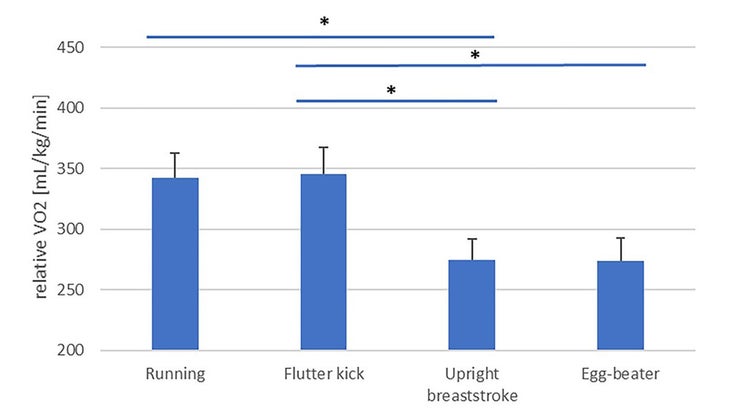OUTSIDE magazine
Alex Hutchinson
Sep 9, 2021
The key? Generate lift.
On a canoe trip down the Spanish River in northern Ontario last month, my friends and I kept noticing an unusually high concentration of really, really big leeches lurking at the shores of our campsites. As a result, our pre-dinner swims involved paddling our canoes out to deep water then jumping in from there.
This gave me lots of time to think about treading water: how long I’d be able to keep it up if necessary, if I was doing it properly, and whether that even mattered.
Imagine my surprise, then, when I got home and saw this paper, just published in Frontiers in Physiology by Tina van Duijn of the University of Otago and her colleagues: “A Multidisciplinary Comparison of Different Techniques Among Skilled Water Treaders.”
They put 21 volunteers, all experienced water polo players, synchronized swimmers, or competitive swimmers who self-identified as water-treading experts, through a series of physiological and cognitive tests while performing four different styles of treading.
The verdict: some techniques really are substantially better than others.
The four techniques are as follows:
Running in the water: This one is pretty self-explanatory. Hands and feet are moving up and down in a running-like motion.
Flutter kick: Your hands are sculling back and forth along the surface of the water, while your legs do a flutter kick.
Upright breaststroke: Your hands are still sculling along the surface of the water, but your legs are doing the distinctive frog kick of the breaststroke.
Eggbeater: It’s similar to the upright breaststroke, with the key difference that your legs are kicking one at a time instead of synchronously, producing an eggbeater pattern of alternating circles with each leg.
Like pretty much everyone who took swimming lessons as a kid, I was taught the eggbeater. But as I floated down the Spanish, I realized that over the years I’ve settled into a comfortable upright breaststroke style as a default. In fact, I wasn’t really sure how to do the eggbeater anymore—which, as I thought back to an article I wrote a few years ago called “How to Survive 75 Hours Alone in the Ocean,” vaguely worried me.
Was I working way harder than I needed to in order to stay afloat?
It turns out I’m not alone in my habits. Among the expert water treaders in the study, 71 percent of them opted for eggbeater in their warm-up, but 14 percent each chose upright breaststroke and flutter kick.
There were clear differences in how efficient the different techniques were, with running and flutter kick performing equally poorly, and upright breaststroke and eggbeater performing equally well. This pattern showed up in every outcome measure.
For example, here’s the oxygen consumption (VO2) during the last portion of 3.5-minute test bouts, measured through a breathing mask attached to a snorkel:
(Photo: Frontiers in Physiology)
Oxygen consumption is roughly proportional to energy consumption, so the lower values for breaststroke and eggbeater mean they’re more efficient than the other two strokes. Aside: these values are adjusted based on the “wet weight” of each participant, which was measured by weighing them underwater.
Normally VO2 measurements are adjusted for weight, since heavier people burn more energy—but in this case, wet weight was used to also account for differences in buoyancy.

As a guy who sinks like a stone in water, I found this interesting!
Similarly, heart rate was higher in running (140 beats per minute, on average) and flutter kick (147) than in breaststroke (129) and eggbeater (129).
Same for perceived effort: 14 and 13 on the Borg scale from 6 to 20, versus 11 and 11, respectively. For cognitive load, they used the NASA-Task Load Index, which assesses things like effort, frustration, and perceived performance, and they tested reaction time in response to visual and audible signals. In both cases, breaststroke and eggbeater produced better results than the other two.
There’s some interesting physics in the stroke comparisons. The two inferior techniques largely rely on pushing down against the water to move the body upward. This has two problems: water is too thin to provide much support, and even when the pushing works you get a lot of wasted up-and-down motion. The two better strokes, in contrast, involve lateral movements of the arms and legs: your cupped hand acts like an airplane wing or sailboat sail, generating lift forces perpendicular to the plane of motion. This is more efficient than pushing on the water, and produces less wasted vertical bobbing.
There’s one key difference between upright breaststroke and the eggbeater: in the former, your legs are kicking outward at the same time, while in the latter they’re alternating. This means that breaststroke produces some of that undesired up (when you kick) and down (between kicks) motion—and that effect is exacerbated if you stop sculling with your hands.
In the eggbeater, there’s always one leg moving, so you get a smoother, more continuous lift that can keep you up even without your hands. The study didn’t test anything that required using your arms—but if you want to throw a water polo ball, strike a fancy pose during your synchro routine, or signal frantically to a passing ship that you need rescue, eggbeater looks like a much better bet. Next time I’m in deep water, I’m going to see if I can get the hang of it again.

No comments:
Post a Comment